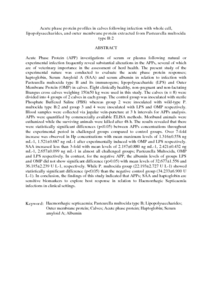Citation
Abdullah, Faez Firdaus Jesse and Osman, Abdinasir Yusuf and Adamu, Lawan and Zakaria, Zunita and Abdullah, Rasedee and Saad, Mohd Zamri and Saharee, Abdul Aziz
(2013)
Acute phase protein profiles in calves following infection with whole cell, lipopolysaccharides, and outer membrane protein extracted from Pasteurella multocida type B:2.
Asian Journal of Animal and Veterinary Advances, 8 (4).
pp. 655-662.
ISSN 1683-9919; ESSN: 1996-3289
Abstract
Acute Phase Protein (APP) investigations of serum or plasma following natural or experimental infection frequently reveal substantial alterations in the APPs, several of which are of veterinary importance in the assessment of herd health. The present study of the experimental nature was conducted to evaluate the acute phase protein responses; haptoglobin, Serum Amyloid A (SAA) and serum albumin in relation to infection with Pasteurella multocida type B and its immunogens; lipopolysaccharide (LPS) and Outer Membrane Protein (OMP) in calves. Eight clinically healthy, non-pregnant and non-lactating Brangus cross calves weighing 150±50 kg were used in this study. The calves (n = 8) were divided into 4 groups of 2 calves in each group. The control group was inoculated with sterile Phosphate Buffered Saline (PBS) whereas group 2 were inoculated with wild-type P. multocida type B:2 and group 3 and 4 were inoculated with LPS and OMP respectively. Blood samples were collected via jugular vein-puncture at 3 h intervals for APPs analysis. APPs were quantified by commercially available ELISA methods. Moribund animals were euthanized while the surviving animals were killed after 48 h. The results revealed that there were statistically significant differences (p<0.05) between APPs concentrations throughout the experimental period in challenged groups compared to control groups. Over 7-fold increase was observed in Hp concentrations with mean maximum levels of 1.316±0.558 ng mL-1, 1.521±0.687 ng mL-1 after experimentally induced with OMP and LPS respectively. SAA increased less than 3-fold with mean levels of 2.187±0.880 ng mL-1, 2.421±0.432 ng mL-1, 2.657±0.099 ng mL-1 in almost all challenged groups; Pasteurella Multocida, OMP and LPS respectively. In contrast, for the negative APP, the albumin levels of groups LPS and OMP did not show significant difference (p>0.05) with mean levels of 32.677±1.556 and 36.185±2.239 U L-1, respectively. While P. multocida group (22.193±2.727 U L-1) showed statistically significant difference (p<0.05) than the negative control group (34.233±6.900 U L-1). In conclusion, the findings of this study indicated that APPs; SAA and haptoglobin are sensitive biomarkers to explore host response in relation to Haemorrhagic Septicaemia infections in clinical settings.
Download File
![[img]](http://psasir.upm.edu.my/29845/1.hassmallThumbnailVersion/Acute%20phase%20protein%20profiles%20in%20calves%20following%20infection%20with%20whole%20cell.pdf)  Preview |
|
PDF (Abstract)
Acute phase protein profiles in calves following infection with whole cell.pdf
Download (86kB)
| Preview
|
|
Additional Metadata
Actions (login required)
 |
View Item |

